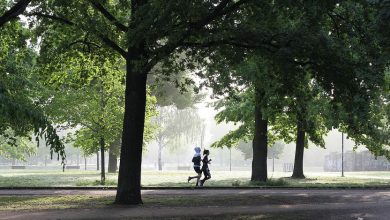
When It Happens by Margaret Atwood is a short story written in third-person, published in 1969 in a collection of Atwood’s short stories. It centers around Mrs. Burridge, as she nervously anticipates a difficult situation and plans ahead as far as she can.
When It Happens | Summary
The story begins with the main character, Mrs. Burridge, putting up green tomato pickles from the tomatoes she grew herself. She is lucky, for she plucked them for her garden when she heard there would be a frost, hence saving them- it makes her feel richer than she did yesterday, though she knows that it will be difficult to finish. Her husband, Frank, will complain, but he’s the one who will eat the most pickle throughout the year. As she thinks more about him, she feels slight remorse at their marriage which seems to have fizzled out. She no longer feels the spark which she thought would last forever.
Mrs. Burridge has been making her own pickle since 1952, and continued to do so even when many friends stopped. She is glad of that now, for she doesn’t have to relearn now as market prices go up and it becomes harder to afford store-bought things. Her husband earns better now than ever before, but the cost of living only rises and she has no faith in money. As the second batch of pickle is simmering, Mrs. Burridge crosses her arms and looks out the window, something she finds herself doing often recently. There isn’t much to see and she doesn’t know what she’s looking at, but she has an idea of smoke coming from the south, which is quite strange. When Frank asks her why she stands there, she makes up a lie, making her feel uneasy. And then, despite all the times he’s made her angry with his attitude, she concludes that he is a good man.
After the pickles cool, she stores them in jars in the old cellar. She once felt safe seeing her cellar stocked with food, thinking she would be prepared for any situation- but not anymore. Now she thinks about leaving, rather than taking shelter in her house, and how she won’t be able to carry the contents of her cellar with her. There is a hole as she goes up the stairs, one Frank won’t fix, and every time she asks he says she’s nagging. But what worries her is there is no one else to fix it if he doesn’t. Mrs. Burridge reveals that there is an air of an impending situation, something everyone is anxiously waiting for. She wants to learn how to use a rifle, but knows she cannot ask Frank or else he will want to know why. And she cannot tell him it’s because maybe he will not be there to protect her- maybe he will be dead, maybe there will be a war like the first.
Mrs. Burridge now heads inside to make her shopping list. She used to plan ahead for occasions like Christmas, but now that is too far ahead to interest her. She walks around the house, takes in the photos, the furniture, all the memories- and suddenly she feels emotional. She hopes her children don’t have children because it is untimely in this dangerous world. She wishes she could be more precise and starts imagining what may happen in the future, days from now. Some men will come up along the road, heading north. Mrs. Burridge will hide one of Frank’s shotguns without his knowledge. She will feel the seriousness and prepare as much as she can, salvaging everything. One morning, Frank will be called for assistance, in the distance where there is smoke and oil. He will look for his shotgun, and will be unable to find it, so he will unusually kiss his wife goodbye before leaving without it, never to return.
Mrs. Burridge, fifty-one, will realize she cannot stay there. She will pack her clothes, food and a toothbrush, unearth the shotgun from where she hid it, and let the animals free- but not past the gate. She will eat and then set off along the road, wondering what would happen if she was wrong and Frank is fine, and everything is normal. She keeps walking- it feels different from driving- and occasionally stops for water. And then as it darkens, she will see two men crouching by a fire, and they will attempt to rob her. She will not let them get the better of her- she has a shotgun, and they want it, but she will have to be fast.
She is afraid, and cannot picture beyond that point. For no matter how much one pictures, they can never imagine how they would truly act in such a situation. In present time, Mrs. Burridge looks at the kitchen clock. She adds an item to her grocery list- they eat more cheese now because meat is too expensive. And then she walks over to the kitchen door and looks out, as has been her nervous habit.
When It Happens | Analysis
When It Happens by Margaret Atwood is a short story written in third person, with an unnamed narrator. The most interesting aspect of this story is it’s shifts between imagination and reality, creating an almost disorienting effect. There is no blatant tense change for a long part of the story- only one or two areas suggest the change between Mrs. Burridge’s mind and her reality. Readers are also unaware whether her thoughts are reasonable or stemming from certain fears or paranoias, which makes it all the more thought-provoking. Atwood employs description and narration more prominently than dialogue. Hence the readers get a clear image of Mrs. Burridge’s setting, while her internal thoughts create an understanding of her relationships and mindsets. The story also contains imagery and symbolism. The main themes are fear, conflict, dependence, isolation and struggle.
Mrs. Burridge references quite a few times- and directly mentions once- that she feels isolated. This may be because she lives in a house with only her and her husband, and her children have moved out. However, it is also important to note that the location of their house is rather isolated, as well. This acts as a physical representation of what Mrs. Burridge feels. A reason for this feeling may be her dwindling marriage- though they have not had any outright confrontation or conversation about it, she mentions thinking they would last forever, yet now she doesn’t even feel like teasing her husband. This fading sense of security that comes with the loss of a spark in marriage may lead to loneliness, adding to the feeling of isolation.
We can also see from several instances that Mrs. Burridge does not think Frank can protect her anymore, whether it is because of his own ability, or because she is sure he will no longer be with her in the future. It is referenced when she sees the hole in the stairs which she had asked him to fix- the realisation that he is the only one who can fix it scares her, because she feels as though she cannot handle her everyday life without him. Here, we explore the theme of dependence. Similarly, when she wants to learn how to use a rifle, it is purely out of the desire to learn how to protect herself. Dependence and fear are interwoven in this aspect- Mrs. Burridge’s realization of how dependent she is on her husband, and hence how helpless she will be if he were to disappear, causes her great fear. Especially with the foreboding sensation she feels, she wishes to prepare herself and become more independent in any way she can.
When Mrs. Burridge is plucking her home-grown green tomatoes, she says she is proud, for it is something she does by herself. The tomatoes symbolize a small essence of her independence- it is her own venture, something she does not need her husband to help with. Nonetheless, she asks him to carry the crates inside, and he “likes it” when she asks, despite his show of annoyance.
It can be assumed that this fear of being helpless is so great that it leads her to imagine possible scenarios she might end up in, and frantically prepare for that. She says herself in the last line that “You never know how you will act in a thing like that until it actually happens.”, which confirms that it was all just her vision of what she thinks will be the future. This vision is most likely constructed as a worst-case scenario for her expectations, and she plans for this so that no matter what, she will be prepared. The constant mention of the war gives us insight to the reason for her fears being heightened. The overall feeling she gets from her surroundings is similar to what she felt during the first war. Often, memories or reminiscent of traumatic experiences can lead to one’s flight-or-fight instinct or traumas getting triggered.
It is an overarching theme throughout the story that Frank preferred the outdoors while Mrs. Burridge preferred the indoors. We may imagine a house with a yard, and Frank being outside while his wife sits inside- this is a picture of a couple separated by a physical wall. This symbolizes the metaphorical wall that seems to be building in their marriage, exploring the theme of conflict. Later, Mrs. Burridge plans to hide her husband’s shotgun so that she can use it when she needs to escape. Readers may think of this as cruel or heartless, but it is also just her way of trying to survive. All her life, she has depended on her husband, and hence she presumably has a higher expectation of his ability to manage and survive a certain situation. Though in her imagination, he does not return home- she imagines that he doesn’t make it- she feels that the shotgun is better used on her than him. She has never killed before, but she has seen how it is done, and she will need it to save herself. Once again, this desperation for survival is triggered by the fear which comes with the acknowledgement of one’s own dependence on another. We may also go as far as to wonder whether Frank did not treat them as equals, but rather asserted his dominance in their marriage because he was a man- the unfortunate norm of a patriarchal society. From a lifetime of such exposure, Mrs. Burridge may believe the same herself, to the point of doubting her own capability and fearing for her life without him. That is what leads her to such extensive preparation.
The story ends with Mrs. Burridge adding cheese to the grocery list because meat is too expensive- yet another reference back to the socio-economic situation. It is important to note that this story was published in 1969, which is the year there was an attack on the Montreal Stock Exchange- Atwood is Canadian, and therefore must have seen the situation first hand. This may have contributed to the theme of this work. Finally, Mrs. Burridge reprises her nervous habit of staring out the kitchen door and into the distance. This symbolizes her nervous anticipation and her belief that something truly is coming.


